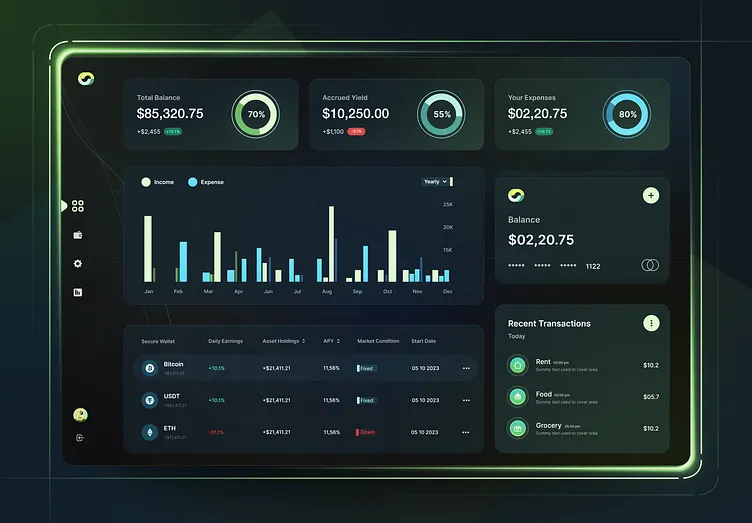In 2025, embedded finance has graduated from experiments to an essential growth driver for equipment-leasing CFOs. By weaving lending, payments, and real-time risk-scoring into procurement platforms, ERP systems, and vendor marketplaces, you’ll slash approval times, widen margins, and unlock new revenue—all without upending your core operations.
For a CFO, this isn’t just another tech rollout—it’s a strategic overhaul of how capital is deployed, risk is underwritten, and customer relationships are cultivated. Below, discover five actionable ways to embed finance into your equipment-leasing workflows, from API-driven credit automation and cash-flow optimization to revenue-enhancement tactics and a clear implementation roadmap. Let’s get started.
Why CFOs Can’t Ignore the Evolution of Embedded Finance in Equipment Leasing
In 2025, the role of a CFO in the equipment leasing sector goes far beyond traditional financial oversight. Embedded finance—the integration of lending, payment solutions, and real-time risk assessment directly into platforms businesses already use—is reshaping the economic landscape dramatically. For CFOs managing equipment leasing portfolios, this evolution presents both strategic imperatives and transformative opportunities.
Understanding Embedded Finance in Equipment Leasing
Embedded finance seamlessly integrates financial services into non-financial platforms, such as procurement systems, vendor marketplaces, and enterprise resource planning (ERP) solutions. By placing financial tools precisely where and when they’re needed, embedded finance simplifies access to capital, dramatically reduces transaction times, and improves overall efficiency.
Key Benefits for CFOs Implementing Embedded Finance
CFOs who integrate embedded finance into their leasing strategies experience:
Faster Approval Processes: Real-time credit scoring and risk assessments mean leases can be approved in hours rather than weeks, providing a significant competitive advantage.
Enhanced Profit Margins: Automating financial operations reduces manual administrative overhead, tightening operational costs, and increasing margins.
New Revenue Streams: Embedding finance creates opportunities to earn from interest, transaction fees, and additional financial services offered through existing leasing platforms.
Strategic Implications of Ignoring Embedded Finance
Ignoring embedded finance can result in:
Competitive Disadvantage: Competitors using embedded finance can process deals more swiftly and efficiently, capturing market share from slower-moving traditional finance models.
Increased Operational Costs: The continued reliance on manual processes or traditional banking integrations often results in higher overhead and slower transaction speeds, ultimately leading to lower profitability.
Missed Revenue Opportunities: Companies that fail to adopt embedded finance miss out on potential revenue from value-added financial services embedded within their leasing operations.
Steps for CFOs to Capitalize on Embedded Finance
To fully leverage embedded finance in equipment leasing, CFOs should:
Evaluate Existing Financial Systems: Assess current procurement and ERP integrations for embedded finance readiness.
Identify Reliable Fintech Partners: Engage with fintech firms specializing in embedded financial solutions tailored to equipment leasing.
Pilot and Scale Solutions: Begin with manageable pilot programs, measure outcomes, and scale effective solutions across the organization.
By proactively embracing embedded finance, CFOs in equipment leasing not only streamline their financial operations but also position their organizations strategically for long-term growth and resilience in an increasingly digital-first economy.
Key APIs & Platforms Powering Embedded Finance for Industrial Asset Funding
In today’s fast-evolving financial ecosystem, APIs (Application Programming Interfaces) and specialized platforms are at the heart of embedded finance, particularly in industrial asset funding. CFOs in equipment leasing must understand and leverage these technological enablers to stay competitive and profitable.
What are APIs and Why are They Critical?
APIs are protocols that enable different software systems to communicate and integrate seamlessly. In equipment leasing, APIs allow for the embedding of sophisticated financial tools directly into ERP (Enterprise Resource Planning) systems, procurement platforms, and vendor marketplaces, facilitating instant transactions and data exchanges.
Essential APIs for Industrial Asset Funding
Credit Scoring APIs: Enable real-time risk assessments by quickly analyzing financial data and creditworthiness, significantly speeding up leasing approvals.
Payment Gateway APIs: Facilitate smooth, instant, and secure transactions within equipment leasing platforms, ensuring payments are timely and transparent.
Data Analytics APIs: Offer predictive insights into financial behavior, asset performance, and leasing patterns, aiding strategic decision-making for CFOs.
Leading Platforms Integrating Embedded Finance
ERP Systems: SAP, Oracle, and Microsoft Dynamics platforms are increasingly embedding finance functionalities, enabling CFOs to manage leasing operations and financial transactions within a single interface.
Procurement Platforms: Platforms like Coupa and Ariba integrate embedded finance solutions, streamlining the procurement and leasing process, reducing administrative overhead, and enhancing cost control.
Vendor Marketplaces: Specialized industrial marketplaces incorporate embedded finance options, providing easy leasing solutions directly at the point of sale, significantly reducing friction and enhancing customer satisfaction.
Strategic Advantages of API Integration for CFOs
By effectively utilizing APIs and platforms, CFOs can:
Accelerate Decision-Making: Instantaneous data sharing and real-time analytics facilitate quicker leasing decisions, providing a competitive edge.
Improve Financial Control: Automated financial processes and real-time transaction monitoring offer enhanced visibility and control over cash flow and operational finances.
Drive Revenue Growth: Efficient integration of embedded finance enables CFOs to capture new revenue streams from financial services embedded directly into their equipment leasing operations.
Steps for CFOs to Implement API-driven Embedded Finance
To capitalize on these powerful technological tools, CFOs should:
Assess Current Systems: Evaluate existing software infrastructure for compatibility with embedded finance APIs.
Select Trusted API Providers: Partner with reputable API providers specialized in financial technology, tailored for equipment leasing.
Integrate and Pilot: Begin with controlled pilot integrations, monitor performance closely, and scale solutions rapidly across the business.
CFOs who proactively integrate these powerful APIs and platforms into their leasing workflows will position their companies at the forefront of innovation, efficiency, and profitability in industrial asset funding.
How Embedded Finance Streamlines Lessee Cash Flow & Approval Times
Embedded finance significantly enhances cash flow management and reduces approval times for equipment leasing. CFOs must leverage these financial innovations to maintain operational efficiency and competitive advantage.
Improving Lessee Cash Flow Management
By embedding finance into existing operational platforms, lessees gain immediate access to funds precisely when required, eliminating delays commonly associated with traditional lending processes. This integration ensures predictable cash flow, enabling better budgeting, financial forecasting, and overall operational stability.
Accelerating Lease Approval Processes
Real-time credit scoring and integrated payment systems streamline the leasing approval cycle dramatically. By automating credit assessments and embedding these processes into ERP and procurement systems, approvals occur significantly faster, reducing turnaround times from weeks to mere hours or even minutes.
Enhanced Financial Visibility and Control
Real-time embedded financial tools provide CFOs and finance teams with unparalleled visibility into the leasing lifecycle. Immediate access to transactional data enables better-informed decisions, reduces financial risk, and improves cash flow predictability.
Strategic Financial Benefits for Lessees
Improved Liquidity: Instant access to embedded finance solutions enhances liquidity, reducing the need for external financing and associated costs.
Reduced Administrative Burden: Automating approvals and payments reduces manual processing, freeing resources for strategic tasks.
Cost Savings: Faster approvals and integrated financial processes lead to lower transaction and operational costs, directly boosting profitability.
Steps CFOs Can Take to Optimize Embedded Finance
Identify Key Operational Gaps: Evaluate current cash flow bottlenecks and delays in approval processes.
Choose Integrated Solutions: Select embedded finance platforms that seamlessly integrate into current systems.
Implement Pilot Programs: Test solutions on a small scale, measure outcomes, and scale successful integrations quickly.
CFOs who leverage embedded finance effectively position their organizations to achieve significant operational efficiencies and financial gains in the competitive leasing landscape.
Unlocking New Revenue & Automated Risk Scoring for Lessors via Embedded Finance
Embedded finance provides lessors with powerful tools to generate new revenue streams and automate risk assessment processes, greatly enhancing the profitability and operational efficiency of equipment leasing companies.
How Embedded Finance Generates New Revenue for Lessors
Embedding financial services directly into leasing platforms creates opportunities to generate additional revenue through interest, transaction fees, and supplementary financial products. This approach allows lessors to monetize existing customer relationships more effectively and diversify their income sources.
Automating Risk Scoring with Real-Time Data
Real-time credit and risk scoring technologies, integrated into embedded finance solutions, provide immediate insights into lessee financial health. This automation significantly reduces the risk assessment timeline, improves decision accuracy, and allows lessors to confidently manage their leasing portfolios.
Strategic Benefits for Lessors
Revenue Diversification: Embedded finance allows lessors to offer ancillary financial products, enhancing profitability and customer retention.
Operational Efficiency: Automated risk scoring and integrated financial processes streamline operations, freeing resources for high-value tasks.
Enhanced Risk Management: Real-time analytics enable proactive risk management, significantly reducing financial uncertainties and losses.
Implementation Steps for CFOs
Evaluate Revenue Opportunities: Identify potential financial services to integrate within current leasing platforms.
Implement Automated Risk Tools: Select and deploy real-time credit scoring and analytics tools.
Monitor and Optimize: Continuously evaluate system performance, adjusting strategies to maximize profitability and minimize risk.
By strategically leveraging embedded finance, CFOs can significantly enhance revenue streams, automate critical risk management processes, and ensure sustained competitive advantage in the dynamic equipment leasing marketplace.
A CFO’s Step-by-Step Roadmap to Embedding Finance in Equipment Leasing
To successfully embed finance into equipment leasing processes, CFOs should follow a structured, strategic approach:
Evaluate Existing Infrastructure: Conduct a comprehensive analysis of current financial systems and their readiness for embedded finance integration.
Identify Suitable Fintech Partners: Select fintech providers specializing in embedded finance solutions tailored to equipment leasing.
Develop Integration Strategy: Plan a phased implementation strategy, clearly defining objectives, timelines, and expected outcomes.
Pilot and Assess: Launch pilot programs to test integrations, rigorously assessing performance metrics and adjusting as necessary.
Scale and Optimize: Expand successful integrations across broader operations, continuously optimizing based on real-time feedback and analytics.
By following this roadmap, CFOs can seamlessly integrate embedded finance, driving significant improvements in efficiency, profitability, and competitive advantage in equipment leasing.






